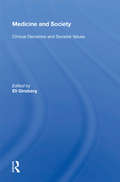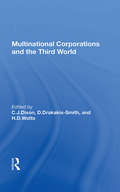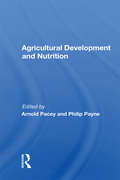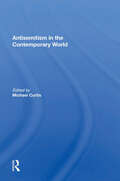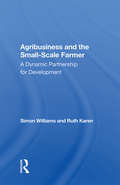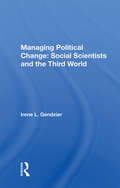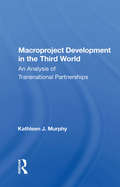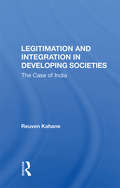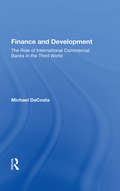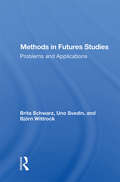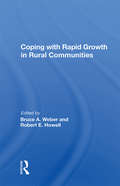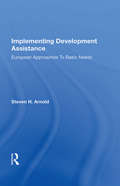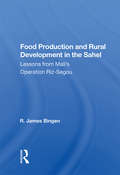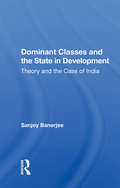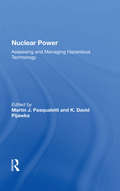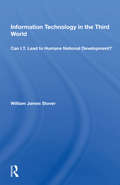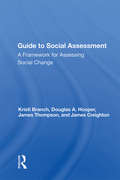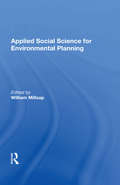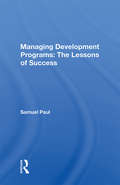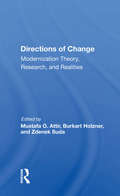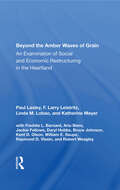- Table View
- List View
Medicine And Society: Clinical Decisions And Societal Values
by Eli GinzbergThis book, based on the Third Conference on Health Policy, is derived from those discussions that identified as a fundamental issue the translation of societal values into health care objectives and the formulation of mechanisms by which these objectives could guide the clinical decision-making.
Multinational Corporations And The Third World
by C.J. DixonThis book, an outcome of the conference in 1983 held at the University of Birmingham, examines the varied roles played by multinational corporations in the economies of the Third World countries and concentrates more closely on regional, national, sectoral or corporate levels.
Agricultural Development And Nutrition
by Arnold Pacey Philip PayneThis book is an expose of the many food consumption-related problems which need to be considered alongside agricultural production issues in development. It examines factors that determine the degree to which people have access to food and can assimilate its nutrients.
Antisemitism In The Contemporary World
by Michael CurtisOriginal essays by various scholars on the questions of whether there are new forms of antisemitism, whether there has been a resurgence of antisemitism in the current age, and whether critical attitudes towards Zionism or opposition to the State of Israel and its policies have given new impetus to antisemitism. The contributors also examine the complex relationship between the State of Israel and the Jewish community worldwide
Agribusiness And The Small-scale Farmer: A Dynamic Partnership For Development
by Simon Williams Ruth KarenBased on case histories from nine Third World countries, this study examines the successful cooperation between private agribusiness firms and small farmers to increase agricultural production and income in developing countries. In such ventures, small farmers are organized around a core private company that buys their output and provides manageria
Managing Political Change: Social Scientists And The Third World
by Irene L. GendzierFor nearly three decades, policymakers and students have been concerned with Third World societies in transition. Conventional interpretations of political change, formalized in studies of political development, have dominated approaches to analyzing such changes. Yet, argues the author, these interpretations have been justly criticized as bankrupt and irrelevant to Third World realities. Why are they reproduced? How can one explain the belief that these approaches remain viable? These are some of the questions addressed in this wideranging review of the literature of political development and the paradigms that have guided analysis of political change over the past thirty years. Examining how political development theories are rooted in U.S. foreign policy, domestic political trends, and changes in postwar political science, Dr. Gendzier grounds the traditional approach to political development in recent history and politics. Her analysis raises questions about how development doctrine is related to foreign policy, as well as noting development theory's debt to cold war ideology and revisionist theories of liberal democracy. Dr. Gendzier's interpretation sheds light on the reasons for the current theoretical bias that favors approaching politics in terms of psychology and culture—an approach that, she states, has had devastating effects on our understanding of politics.
Dictionaries British and American
by James Root HulbertThis book presents a detailed explanation of the essential facts of dictionaries in general. It includes information on the origin of English dictionaries and the authority and choice of a dictionary.
Macroproject Development In The Third World: An Analysis Of Transnational Partnerships
by Kathleen J. MurphyDuring the 1970s an unprecedented number of large-scale, projects of various kinds were launched in the Third World. Many multinational corporations that were experienced in initiating such projects in industrialized nations encountered unanticipated difficulties and risks in the new settings. This book assesses the experiences of multinationals and host nations and offers guidelines for effectively implementing macroprojects in developing areas. The author synthesizes data from more than 1600 macroprojects conducted during the 1970s; statistical information was supplemented by on-site surveys and interviews. She emphasizes that the successful development of a large-scale project hinges on the effective coordination of numerous individuals and groups—owners, project management contractors, indigeneous and foreign workers, financiers, government ministeries, consumers, etc. The key to success, she concludes, lies in anticipating and managing for sociocultural discontinuities and in setting up an adequate audit of organizational effectiveness. The guidelines resulting from her analysis are intended to assist multinational corporations and their host counterparts in understanding the new arrangements and approaches needed to successfully manage the macroprojects of the future.
Legitimation And Integration In Developing Societies: The Case Of India
by Reuven KahaneThis book focuses on general theoretical considerations important for the analysis of political legitimation and integration in diverse societies. It suggests a model of society in which conflicts are accentuated for integrative purposes.
Finance And Development: The Role Of International Commercial Banks In The Third World
by Michael DaCostaAlthough commercial banks have played an increasingly important role in providing capital to developing nations, many analysts argue that private financing poses risks both to borrowing nations and the stability of the international economic system. In response, Mr. DaCosta demonstrates that developing nations that adopt appropriate policies can gain substantially by drawing on private sources of capital. His analysis indicates that many criticisms of the role of commercial banks are unfounded and that debt problems in LDCs typically are related to inadequate reserve and external debt management policies in the borrowing countries themselves. Emphasizing that economic growth in LDCs often is constrained by balance-of-payment deficits, Mr. DaCosta shows that nations relying on private capital frequently experience higher-than-average growth rates and argues that the advantages of unconditional or untied aid generally outweigh the constraints imposed by the multilateral aid agencies. In conclusion, he outlines specific policies developing nations can adopt to reduce financial risk and, turning to the needs of the poorest of the LDCs, examines a variety of proposals aimed at increasing the flow of concessional assistance to those countries that cannot qualify for commercial bank funds.
Methods In Futures Studies: Problems And Applications
by Brita SchwarzThis book presents three examples of futures research that illustrate the problems of applying knowledge during the course of a futures research project, the ways in which different methodologies interact, and various means of combining and adapting methodological tools and techniques.
Coping With Rapid Growth In Rural Communities
by Bruce A. WeberThis book integrates the most current research findings on the economic, demographic, fiscal, and social consequences of rapid growth in rural communities and offers strategies that can be used to mitigate the often disruptive impact of that growth. While working extensively with government officials and citizens in rural communities, Drs. Weber and Howell became aware of the need for a compilation and synthesis of the research on rural growth; they subsequently invited scholars working in selected topic areas to contribute to that effort. The resulting papers were refined during a meeting sponsored by the Western Rural Development Center, edited, and brought together in this volume. Incorporating 1980 census data, the book outlines the spectrum of changes associated with rapid growth in rural areas, presents specific options for managing rapid growth, and suggests a model that communities can use for impact assessment and for monitoring the effectiveness of various management strategies.
Implementing Development Assistance: European Approaches To Basic Needs
by Steven H. ArnoldAlthough much has been written about development assistance to the Third World, nearly all the attention has focused on U.S. programs and policy. The important and growing commitment of European countries--which now collectively account for over half of all development assistance provided by the industrialized nations--has been virtually ignored. European nations, like the u.s., support in principle a “basic needs†focus in their assistance programs, but the strategies they employ reveal a variety of styles and technical approaches, many of which could be useful in improving U.S. aid programs. This study describes and analyzes the development assistance programs of the five major European donors: France, Germany, the Netherlands, the United Kingdom, and Sweden. Drawing on primary sources and interviews with representatives of the various assistance agencies and with outside experts, Dr. Arnold describes each country’s program in terms of three general areas: the evolution of its philosophy and overall policy goals, the organizational structure of the government institutions concerned with development assistance (including the relationship of these institutions to legislative and other policymaking bodies), and the content and procedures of the assistance programs.
Food Production And Rural Development In The Sahel: Lessons From Mali's Operation Riz-segou
by R. James BingenIn Mali and throughout the Sahel, governments increasingly rely on parastatal organizations to overcome the problems of lagging food production and rural poverty. This book examines the political and economic consequences of the efforts of one organization, Operation Riz-Segou in Mali, to increase smallholder food and cash crop production. Drawing extensively on fieldwork in Mali, the author finds that significant investments in irrigation facilities, financed by foreign aid, have not reduced the smallholder's vulnerability to the risks posed by weather and uncertain flood levels of the Niger River. The extension system discourages smallholder investment for long-term agricultural development because of its preoccupation with supervision and administrative control. Moreover, the Operation engages in many popular rural development activities—literacy programs, farmer training, women's artisanal centers—that give the facade of grassroots participation but in reality do not provide villagers a critically needed voice in local program administration. Comparing Operation Riz-Segou to similar parastatal agricultural development programs in the Sahel, Dr. Bingen discusses why only those policies deliberately designed and carefully implemented to share power with the majority of the people can lay the political and economic foundation required to overcome rural poverty and resolve the food crisis in the Sahel.
Dominant Classes And The State In Development: Theory And The Case Of India
by Sanjoy BanerjeeWhy does capitalist development give rise to political alliances between the state and certain economically dominant classes? Addressing this question, Professor Banerjee uses an evolutionary approach to social structure to develop a theory of the interaction within and among business and manufacturing firms--a theory that highlights those aspects of market processes that promote the formation of dominant economic classes. Structural-evolutionary conceptions of property relations and of state planning and regulation are developed and combined with the market model. According to Professor Banerjee, the market, property relations, and state administration form a self-sustaining structure that simultaneously develops the economy in an uneven and clustered fashion and gives rise to a "dominant alliance" between a segment of the state and the fastest-accumulating classes in the economy. He applies his model to India during the 1956-1975 period, examining the industrialization process of the Second and Third plans, the crisis of the mid-1960s, and the Green Revolution.
Nuclear Power: Assessing And Managing Hazardous Technology
by Martin J PasqualettiAddressing the major issues surrounding the use of nuclear power, twenty-nine social scientists with extensive involvement in the assessment and management of nuclear technology discuss critical areas of concern--problem recognition, risk estimation, and policy formation and implementation. The authors appraise fundamental policy issues and examine
Information Technology In The Third World: Can I.T. Lead To Humane National Development?
by William James StoverMass media, telecommunications, and computer technology can effect change in poor countries, but Third World leaders are often disappointed in the results. Professor Stover looks closely at information technology and communication as agents of economic, social, and political development in Third World countries, stressing that definitions of "communication" and "development" must include participation in the exchange of information and the attainment of humane values. He examines reasons why the current world information order does not meet the needs of the Third World and argues that the major difficulty in achieving the potential of information technology for humane development is a cyclical pattern involving technology and values. When countries acquire the physical means of communication, their leaders are tempted to control them, resulting in censorship that prevents genuine communication. Breaking this cycle is a major requirement in using information technology for development, and Dr. Stover discusses how this may be accomplished practically in developmental, Western, and Soviet contexts.
Guide To Social Impact Assessment: A Framework For Assessing Social Change
by Kristi BranchDesigned to provide clear and detailed assistance in the complex process of assessing social change, this book emphasizes the development of an analytic approach and a theoretical framework that can be applied to the assessment of very diverse events--changes in the natural environment, the local economy, or the dominant technology. The guide, based on a sociological perspective that highlights the importance of community social organization in analyzing social change, focuses on the development of user skills in assessment design, research, analysis, and presentation. The guide's theoretical basis and emphasis on the interrelationships that create social change make it valuable to those studying social change in general, as well as to those responsible for conducting or utilizing social impact assessments. Detailed "how to" information, clear writing, and careful design impart the skills necessary to identify and analyze the factors and processes leading to social change and to interpret and present research findings in an effective manner.
Applied Social Science For Environmental Planning
by William MillsapAs regions and communities are increasingly affected by the projects, programs, and policies of disparate government and private groups, the skills of social scientists are being called on to aid in the environmental planning process. This volume presents accounts of the many ways in which the social sciences are contributing to environmental planning. The authors, drawing on case studies and displaying a wide range of theoretical and methodological approaches, address the transition from theory to practice in environmental planning, local-level contributions to the planning process, socioeconomic development and planning needs, and socioenvironmental planning and mitigation procedures.
New Jersey: A Geography (Haunted Ser. #Vol. 8)
by Charles A. StansfieldNew Jersey. The name evokes many images, most of which are narrow stereotypes that fall short of reality. For example, though New Jersey's salient cultural characteristic is its high population density–the highest in the United States and higher than that of Britain–there is a surprising amount of open space in the state. Areas of the pinelands remain virtually unexplored, vast bogs are nearly impenetrable, and lush forests on the Appalachian ridges and holly-decked beaches on the ocean invite the city-weary urbanite. This geographic study of New Jersey, a multidimensional portrait of the state, incorporates three major themes: (1) the state's cultural diversity, an amalgam dating from colonial days, of many varied ethnic, national, and racial groups; (2) its bipolar orientation to two neighboring giant metropolitan areas, New York and Philadelphia, again a factor that dates to the time of the Revolution; and (3) an economy heavily influenced by the state's accessibility to major metropolitan centers and its well-developed corridor functions. Dr. Stansfield depicts New Jersey as a state others should watch: How it controls suburban sprawl, environmental deterioration, and the internal competition among agricultural, suburban, industrial, and recreational uses of land and water resources offers a model for the rest of the United States. Newark's Mayor Gibson observed of his city, "I don't know where America's cities are going, but I think Newark will get there first." It also might be fairly concluded, writes Dr. Stansfield, that wherever the United States is heading, New Jersey could get there first.
Colorado: A Geography
by Mel GriffithsColorado—seen as "the" place to ski, the ideal environment to live in, and a source of energy the country needs desperately—is best understood, write the authors of this descriptive and interpretive geography, as part of its regional setting. Water that flows from Colorado's snowfields supplies irrigation water for crops as far away as California. Tourists have a stake in Colorado's environment, as well as its economy. Colorado's vast energy and mineral resources cannot be developed without consideration of the impact on surrounding states. And many aspects of Colorado's future are dependent on influences that come from beyond the state's political boundaries. Colorado, incorporating the most recent (1980) census data and illustrated with more than 200 photographs, tables, and figures, is the only up-to-date geography of the state available. The authors look at Colorado first from the perspective of the physical setting it shares with its neighbors and then examine the interaction of people with the land. They also analyze Colorado's major industries—agriculture, tourism, mining, and manufacturing—and describe such Colorado phenomena as the way population tends to aggregate along the eastern slope of the mountains and how this population concentration has affected agriculture, water use, and industrial development. Numerous examples illustrate the practical workings of the complex interrelationships between Colorado's environment and its inhabitants. The book is designed to serve both as a text for courses in Colorado and Rocky Mountain geography, and as an authoritative source of information about the state for newcomers, as well as long-time residents.
Managing Development Programs: The Lessons Of Success
by Samuel PaulThis book explores a neglected dimension - the role of management interventions in development programs. It investigates two basic questions: what are the management and institutional interventions associated with successful development programs? what lessons can we learn from their experience?
Directions Of Change & Modernization Theory, Research, And Realities: Modernization Theory, Research, And Realities
by Mustafa O AttirAfter a period of relative confidence about the future of modernizing societies, scholars are now questioning with renewed urgency the directions of the modernization trend. This book, the result of nearly a decade of collaborative efforts by scholars in twelve countries, examines the modernization process with particular attention to how it is aff
Developmental Psychology For The Health Care Professions, Part Ii: Young Adult Through Late Aging
by Howard. S. FeldmanFirst published in 1982. Since the 1960s, there has been growing interest in and research on the adult years of the life cycle. Previously, developmental studies had focused on childhood and adolescence, in which an orderly relationship between age and growth was assumed. This volume looks at three periods of adulthood identified on the basis of chronological age: young adulthood, from 18 to 40; middle adulthood, from 40 to 65; and later adulthood, from 65 until death. The authors of the series volumes are behavioral scientists with considerable experience in the education of health care professionals. Most of them are also clinicians, and their varied experience enables them to present their topics in a readable fashion. The content of the texts presumes only a very basic knowledge of the behavioral sciences, and emphasis is placed on the practical implications of research findings for health care delivery.
Beyond The Amber Waves Of Grain: An Examination Of Social And Economic Restructuring In The Heartland
by Paul LasleyThis book explores the large-scale impacts of economic restructuring in the Midwest in response to the 1980s farm crisis. Drawing upon detailed surveys from twelve north-central states, the authors offer a comprehensive view of farm restructuring and its social, economic, and political consequences. The study goes beyond the farm gate to look at the broader implications of those changes for agriculture policy, related industries, and areas still dependent upon farming, contributing to the literature on economic restructuring. Like the factory closings in the Rust Belt, the dramatic failure of agricultural industries in the Farm Belt has caused fundamental changes in the organization and control of production. The impact of job losses and economic depression and the shattering of a way of life have shaken public complacency about the stability of many fundamental American myths. Beyond the Amber Waves of Grain looks at the farm crisis not as a purely agricultural, nonurban issue but as one that adds to our understanding of the overall social impacts of economic change. The book takes up the story of Midwestern farm enterprises in the wake of the farm crisis of the 1980s. Using data drawn from detailed surveys of 3,940 farm households in twelve north-central states, the authors offer a comprehensive view of the social and economic restructuring of agriculture and explore the consequences for farm enterprises, farm households, and farming communities. The study goes beyond the farm gate to look at the broader implications for related industries and communities dependent upon farming, for agricultural and rural policies, and for farm women and men, contributing to the literature on economic restructuring and its outcomes.
